Business Analysis of GUTS Ticketing for Event Management Solutions
VerifiedAdded on 2023/01/18
|13
|3975
|89
Report
AI Summary
This report examines the social problem of ticket booking, focusing on the impact of black market traders and inflated ticket prices in the event industry. It proposes GUTS Ticketing as a 'Smart Ticketing' solution to address these issues by leveraging blockchain technology to create a transparent and controlled ticketing system. The report provides an introduction to the problem, facts and figures related to the secondary ticketing market, and a detailed analysis of the GUTS Ticketing solution. It employs CATWOE and UTAUT analyses to evaluate the system's effectiveness, considering factors such as performance expectancy, effort expectancy, social influence, and facilitating conditions. The study highlights the benefits of GUTS Ticketing, including price control, transparency, and the elimination of fraudulent activities, offering a comprehensive overview of its potential to revolutionize event ticket management. The report also covers existing online show booking systems like Aventus and Skedda.
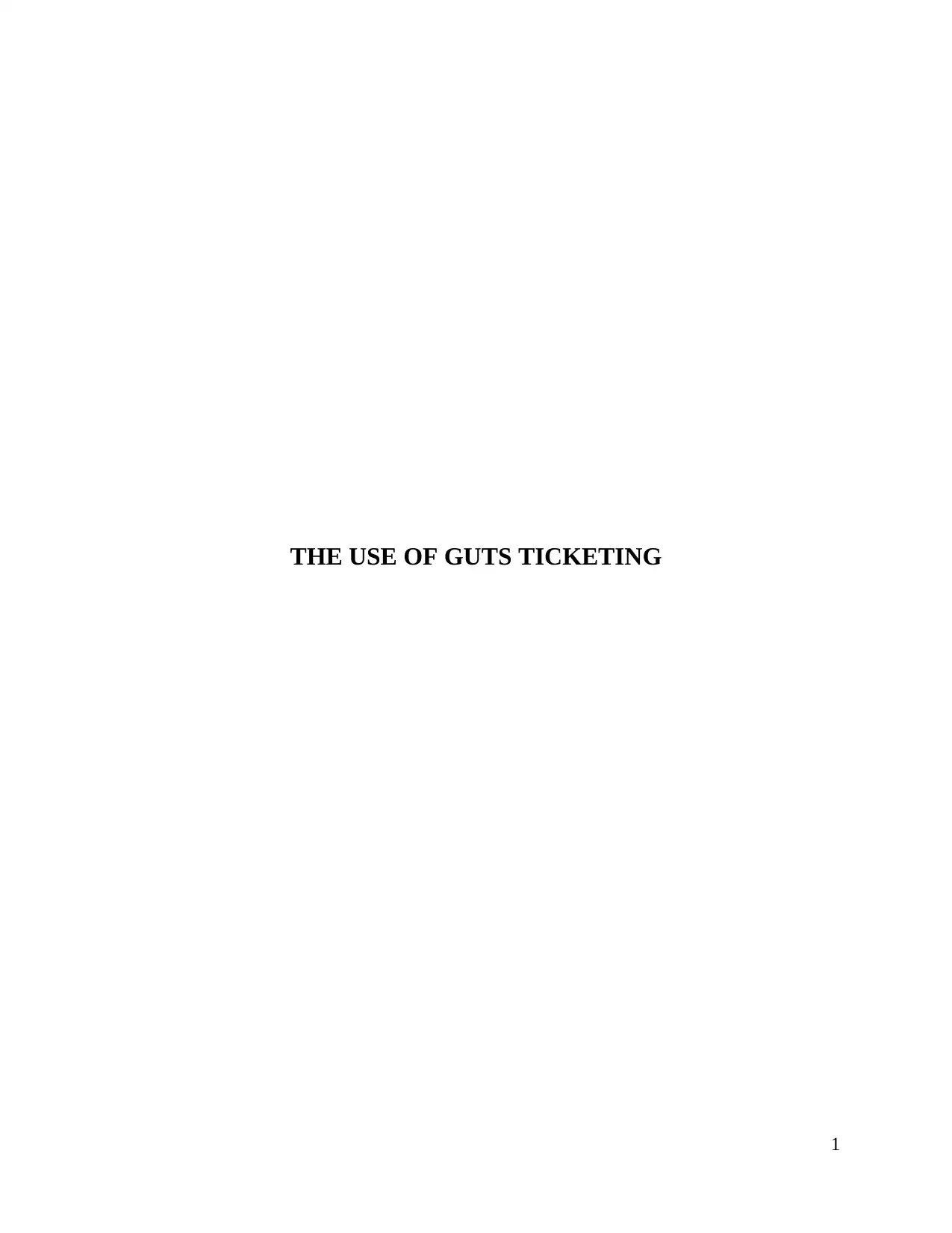
THE USE OF GUTS TICKETING
1
1
Paraphrase This Document
Need a fresh take? Get an instant paraphrase of this document with our AI Paraphraser
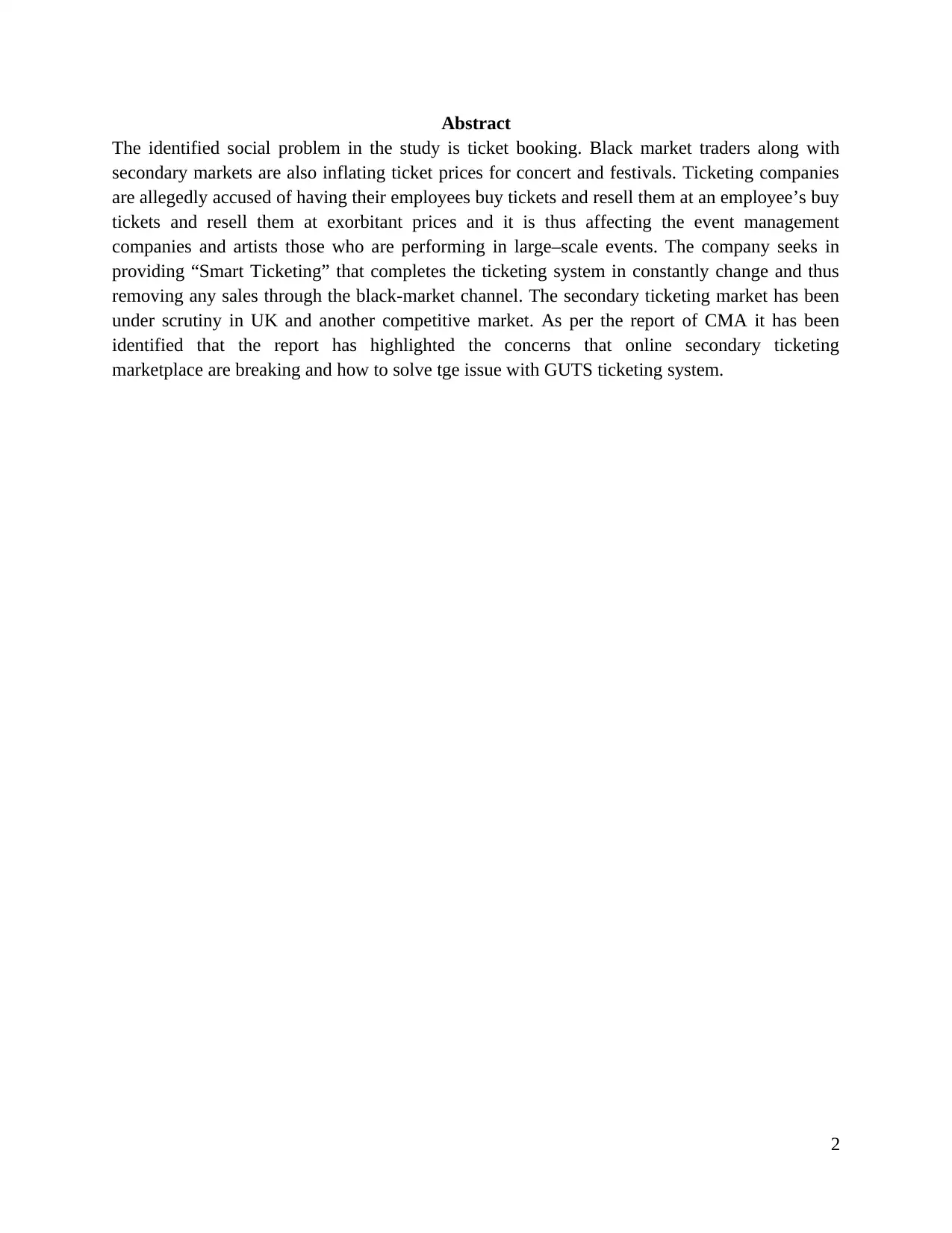
Abstract
The identified social problem in the study is ticket booking. Black market traders along with
secondary markets are also inflating ticket prices for concert and festivals. Ticketing companies
are allegedly accused of having their employees buy tickets and resell them at an employee’s buy
tickets and resell them at exorbitant prices and it is thus affecting the event management
companies and artists those who are performing in large–scale events. The company seeks in
providing “Smart Ticketing” that completes the ticketing system in constantly change and thus
removing any sales through the black-market channel. The secondary ticketing market has been
under scrutiny in UK and another competitive market. As per the report of CMA it has been
identified that the report has highlighted the concerns that online secondary ticketing
marketplace are breaking and how to solve tge issue with GUTS ticketing system.
2
The identified social problem in the study is ticket booking. Black market traders along with
secondary markets are also inflating ticket prices for concert and festivals. Ticketing companies
are allegedly accused of having their employees buy tickets and resell them at an employee’s buy
tickets and resell them at exorbitant prices and it is thus affecting the event management
companies and artists those who are performing in large–scale events. The company seeks in
providing “Smart Ticketing” that completes the ticketing system in constantly change and thus
removing any sales through the black-market channel. The secondary ticketing market has been
under scrutiny in UK and another competitive market. As per the report of CMA it has been
identified that the report has highlighted the concerns that online secondary ticketing
marketplace are breaking and how to solve tge issue with GUTS ticketing system.
2
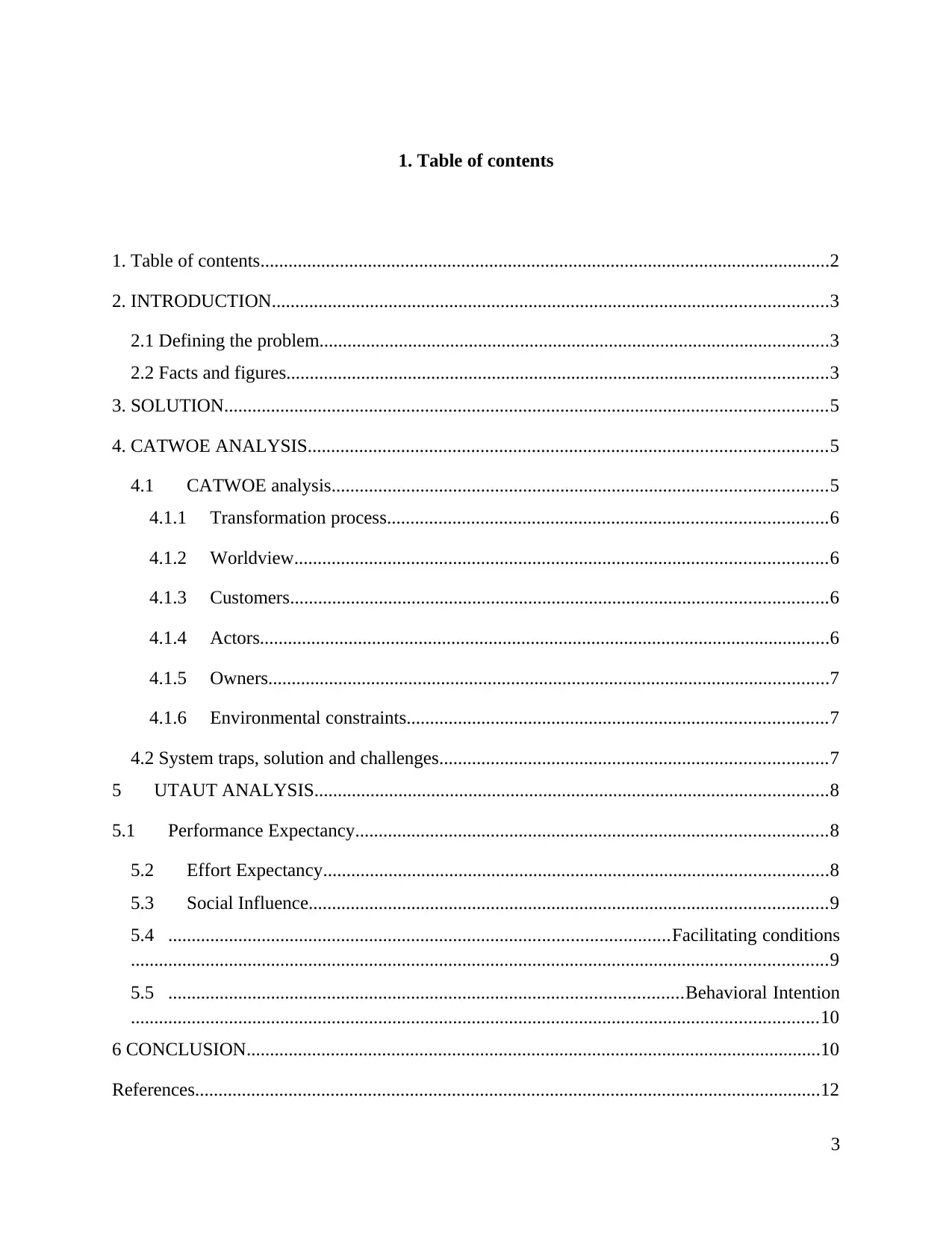
1. Table of contents
1. Table of contents..........................................................................................................................2
2. INTRODUCTION.......................................................................................................................3
2.1 Defining the problem.............................................................................................................3
2.2 Facts and figures....................................................................................................................3
3. SOLUTION.................................................................................................................................5
4. CATWOE ANALYSIS...............................................................................................................5
4.1 CATWOE analysis..........................................................................................................5
4.1.1 Transformation process..............................................................................................6
4.1.2 Worldview..................................................................................................................6
4.1.3 Customers...................................................................................................................6
4.1.4 Actors..........................................................................................................................6
4.1.5 Owners........................................................................................................................7
4.1.6 Environmental constraints..........................................................................................7
4.2 System traps, solution and challenges...................................................................................7
5 UTAUT ANALYSIS..............................................................................................................8
5.1 Performance Expectancy.....................................................................................................8
5.2 Effort Expectancy............................................................................................................8
5.3 Social Influence...............................................................................................................9
5.4 ...........................................................................................................Facilitating conditions
.....................................................................................................................................................9
5.5 ..............................................................................................................Behavioral Intention
...................................................................................................................................................10
6 CONCLUSION...........................................................................................................................10
References......................................................................................................................................12
3
1. Table of contents..........................................................................................................................2
2. INTRODUCTION.......................................................................................................................3
2.1 Defining the problem.............................................................................................................3
2.2 Facts and figures....................................................................................................................3
3. SOLUTION.................................................................................................................................5
4. CATWOE ANALYSIS...............................................................................................................5
4.1 CATWOE analysis..........................................................................................................5
4.1.1 Transformation process..............................................................................................6
4.1.2 Worldview..................................................................................................................6
4.1.3 Customers...................................................................................................................6
4.1.4 Actors..........................................................................................................................6
4.1.5 Owners........................................................................................................................7
4.1.6 Environmental constraints..........................................................................................7
4.2 System traps, solution and challenges...................................................................................7
5 UTAUT ANALYSIS..............................................................................................................8
5.1 Performance Expectancy.....................................................................................................8
5.2 Effort Expectancy............................................................................................................8
5.3 Social Influence...............................................................................................................9
5.4 ...........................................................................................................Facilitating conditions
.....................................................................................................................................................9
5.5 ..............................................................................................................Behavioral Intention
...................................................................................................................................................10
6 CONCLUSION...........................................................................................................................10
References......................................................................................................................................12
3
⊘ This is a preview!⊘
Do you want full access?
Subscribe today to unlock all pages.

Trusted by 1+ million students worldwide
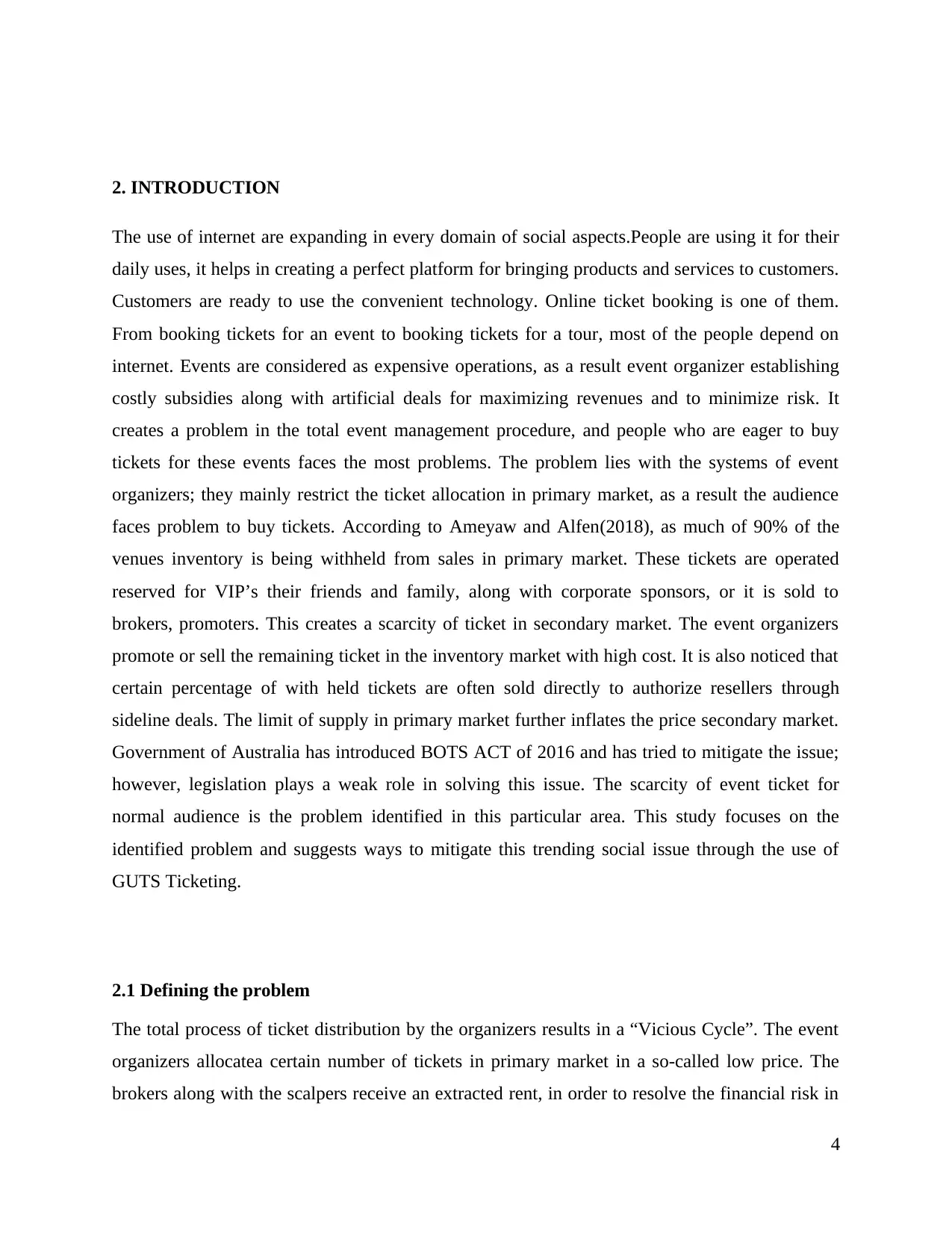
2. INTRODUCTION
The use of internet are expanding in every domain of social aspects.People are using it for their
daily uses, it helps in creating a perfect platform for bringing products and services to customers.
Customers are ready to use the convenient technology. Online ticket booking is one of them.
From booking tickets for an event to booking tickets for a tour, most of the people depend on
internet. Events are considered as expensive operations, as a result event organizer establishing
costly subsidies along with artificial deals for maximizing revenues and to minimize risk. It
creates a problem in the total event management procedure, and people who are eager to buy
tickets for these events faces the most problems. The problem lies with the systems of event
organizers; they mainly restrict the ticket allocation in primary market, as a result the audience
faces problem to buy tickets. According to Ameyaw and Alfen(2018), as much of 90% of the
venues inventory is being withheld from sales in primary market. These tickets are operated
reserved for VIP’s their friends and family, along with corporate sponsors, or it is sold to
brokers, promoters. This creates a scarcity of ticket in secondary market. The event organizers
promote or sell the remaining ticket in the inventory market with high cost. It is also noticed that
certain percentage of with held tickets are often sold directly to authorize resellers through
sideline deals. The limit of supply in primary market further inflates the price secondary market.
Government of Australia has introduced BOTS ACT of 2016 and has tried to mitigate the issue;
however, legislation plays a weak role in solving this issue. The scarcity of event ticket for
normal audience is the problem identified in this particular area. This study focuses on the
identified problem and suggests ways to mitigate this trending social issue through the use of
GUTS Ticketing.
2.1 Defining the problem
The total process of ticket distribution by the organizers results in a “Vicious Cycle”. The event
organizers allocatea certain number of tickets in primary market in a so-called low price. The
brokers along with the scalpers receive an extracted rent, in order to resolve the financial risk in
4
The use of internet are expanding in every domain of social aspects.People are using it for their
daily uses, it helps in creating a perfect platform for bringing products and services to customers.
Customers are ready to use the convenient technology. Online ticket booking is one of them.
From booking tickets for an event to booking tickets for a tour, most of the people depend on
internet. Events are considered as expensive operations, as a result event organizer establishing
costly subsidies along with artificial deals for maximizing revenues and to minimize risk. It
creates a problem in the total event management procedure, and people who are eager to buy
tickets for these events faces the most problems. The problem lies with the systems of event
organizers; they mainly restrict the ticket allocation in primary market, as a result the audience
faces problem to buy tickets. According to Ameyaw and Alfen(2018), as much of 90% of the
venues inventory is being withheld from sales in primary market. These tickets are operated
reserved for VIP’s their friends and family, along with corporate sponsors, or it is sold to
brokers, promoters. This creates a scarcity of ticket in secondary market. The event organizers
promote or sell the remaining ticket in the inventory market with high cost. It is also noticed that
certain percentage of with held tickets are often sold directly to authorize resellers through
sideline deals. The limit of supply in primary market further inflates the price secondary market.
Government of Australia has introduced BOTS ACT of 2016 and has tried to mitigate the issue;
however, legislation plays a weak role in solving this issue. The scarcity of event ticket for
normal audience is the problem identified in this particular area. This study focuses on the
identified problem and suggests ways to mitigate this trending social issue through the use of
GUTS Ticketing.
2.1 Defining the problem
The total process of ticket distribution by the organizers results in a “Vicious Cycle”. The event
organizers allocatea certain number of tickets in primary market in a so-called low price. The
brokers along with the scalpers receive an extracted rent, in order to resolve the financial risk in
4
Paraphrase This Document
Need a fresh take? Get an instant paraphrase of this document with our AI Paraphraser
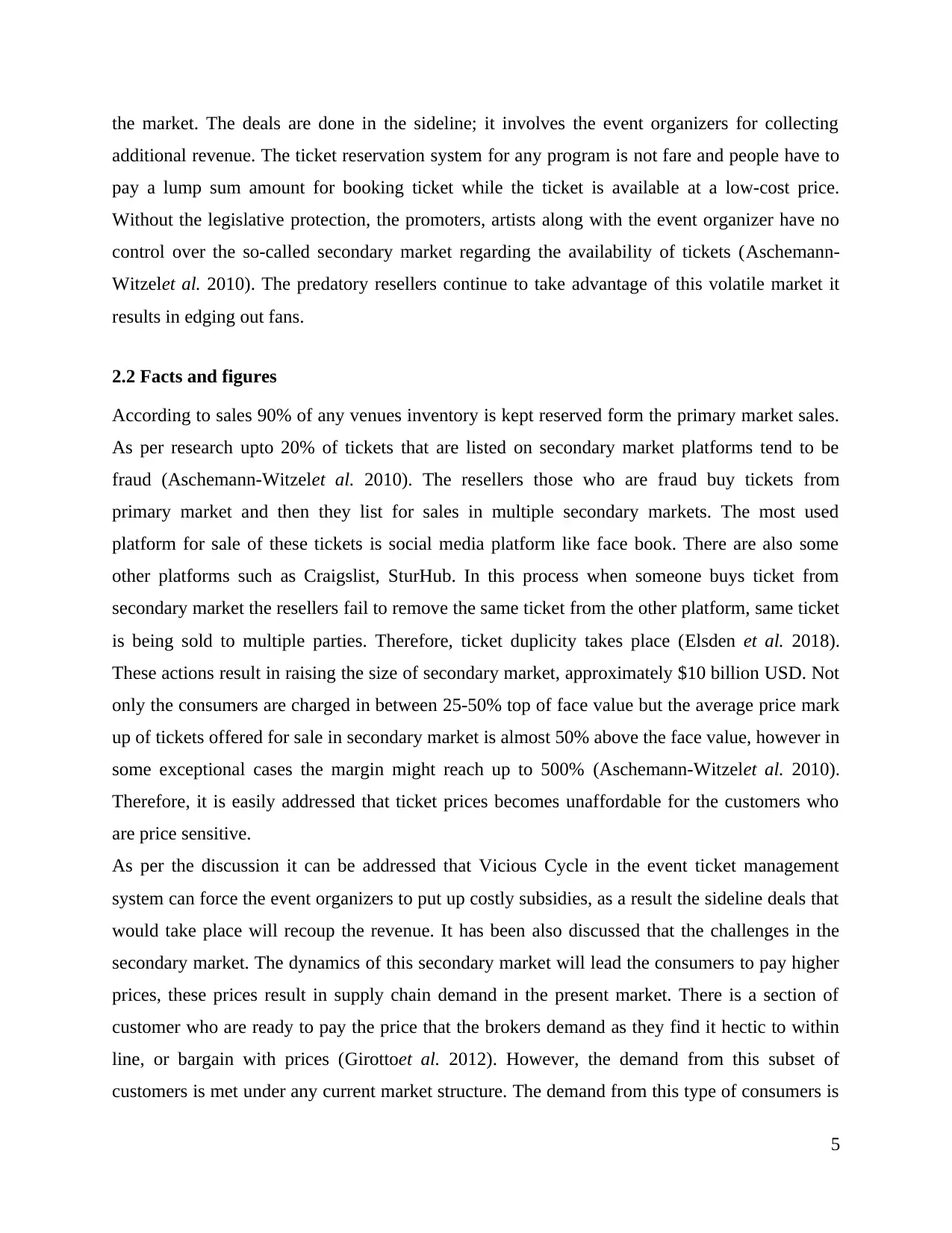
the market. The deals are done in the sideline; it involves the event organizers for collecting
additional revenue. The ticket reservation system for any program is not fare and people have to
pay a lump sum amount for booking ticket while the ticket is available at a low-cost price.
Without the legislative protection, the promoters, artists along with the event organizer have no
control over the so-called secondary market regarding the availability of tickets (Aschemann-
Witzelet al. 2010). The predatory resellers continue to take advantage of this volatile market it
results in edging out fans.
2.2 Facts and figures
According to sales 90% of any venues inventory is kept reserved form the primary market sales.
As per research upto 20% of tickets that are listed on secondary market platforms tend to be
fraud (Aschemann-Witzelet al. 2010). The resellers those who are fraud buy tickets from
primary market and then they list for sales in multiple secondary markets. The most used
platform for sale of these tickets is social media platform like face book. There are also some
other platforms such as Craigslist, SturHub. In this process when someone buys ticket from
secondary market the resellers fail to remove the same ticket from the other platform, same ticket
is being sold to multiple parties. Therefore, ticket duplicity takes place (Elsden et al. 2018).
These actions result in raising the size of secondary market, approximately $10 billion USD. Not
only the consumers are charged in between 25-50% top of face value but the average price mark
up of tickets offered for sale in secondary market is almost 50% above the face value, however in
some exceptional cases the margin might reach up to 500% (Aschemann-Witzelet al. 2010).
Therefore, it is easily addressed that ticket prices becomes unaffordable for the customers who
are price sensitive.
As per the discussion it can be addressed that Vicious Cycle in the event ticket management
system can force the event organizers to put up costly subsidies, as a result the sideline deals that
would take place will recoup the revenue. It has been also discussed that the challenges in the
secondary market. The dynamics of this secondary market will lead the consumers to pay higher
prices, these prices result in supply chain demand in the present market. There is a section of
customer who are ready to pay the price that the brokers demand as they find it hectic to within
line, or bargain with prices (Girottoet al. 2012). However, the demand from this subset of
customers is met under any current market structure. The demand from this type of consumers is
5
additional revenue. The ticket reservation system for any program is not fare and people have to
pay a lump sum amount for booking ticket while the ticket is available at a low-cost price.
Without the legislative protection, the promoters, artists along with the event organizer have no
control over the so-called secondary market regarding the availability of tickets (Aschemann-
Witzelet al. 2010). The predatory resellers continue to take advantage of this volatile market it
results in edging out fans.
2.2 Facts and figures
According to sales 90% of any venues inventory is kept reserved form the primary market sales.
As per research upto 20% of tickets that are listed on secondary market platforms tend to be
fraud (Aschemann-Witzelet al. 2010). The resellers those who are fraud buy tickets from
primary market and then they list for sales in multiple secondary markets. The most used
platform for sale of these tickets is social media platform like face book. There are also some
other platforms such as Craigslist, SturHub. In this process when someone buys ticket from
secondary market the resellers fail to remove the same ticket from the other platform, same ticket
is being sold to multiple parties. Therefore, ticket duplicity takes place (Elsden et al. 2018).
These actions result in raising the size of secondary market, approximately $10 billion USD. Not
only the consumers are charged in between 25-50% top of face value but the average price mark
up of tickets offered for sale in secondary market is almost 50% above the face value, however in
some exceptional cases the margin might reach up to 500% (Aschemann-Witzelet al. 2010).
Therefore, it is easily addressed that ticket prices becomes unaffordable for the customers who
are price sensitive.
As per the discussion it can be addressed that Vicious Cycle in the event ticket management
system can force the event organizers to put up costly subsidies, as a result the sideline deals that
would take place will recoup the revenue. It has been also discussed that the challenges in the
secondary market. The dynamics of this secondary market will lead the consumers to pay higher
prices, these prices result in supply chain demand in the present market. There is a section of
customer who are ready to pay the price that the brokers demand as they find it hectic to within
line, or bargain with prices (Girottoet al. 2012). However, the demand from this subset of
customers is met under any current market structure. The demand from this type of consumers is
5
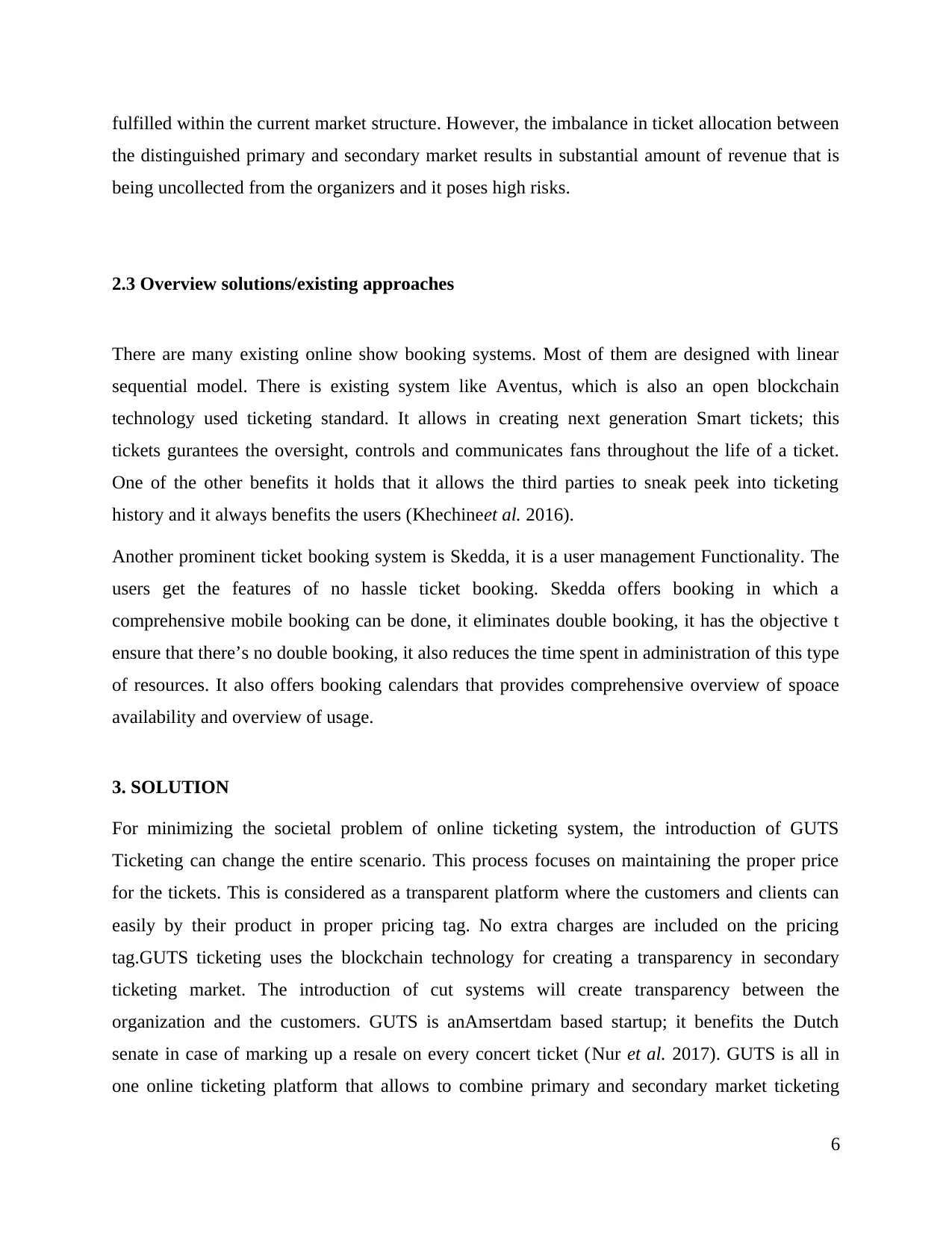
fulfilled within the current market structure. However, the imbalance in ticket allocation between
the distinguished primary and secondary market results in substantial amount of revenue that is
being uncollected from the organizers and it poses high risks.
2.3 Overview solutions/existing approaches
There are many existing online show booking systems. Most of them are designed with linear
sequential model. There is existing system like Aventus, which is also an open blockchain
technology used ticketing standard. It allows in creating next generation Smart tickets; this
tickets gurantees the oversight, controls and communicates fans throughout the life of a ticket.
One of the other benefits it holds that it allows the third parties to sneak peek into ticketing
history and it always benefits the users (Khechineet al. 2016).
Another prominent ticket booking system is Skedda, it is a user management Functionality. The
users get the features of no hassle ticket booking. Skedda offers booking in which a
comprehensive mobile booking can be done, it eliminates double booking, it has the objective t
ensure that there’s no double booking, it also reduces the time spent in administration of this type
of resources. It also offers booking calendars that provides comprehensive overview of spoace
availability and overview of usage.
3. SOLUTION
For minimizing the societal problem of online ticketing system, the introduction of GUTS
Ticketing can change the entire scenario. This process focuses on maintaining the proper price
for the tickets. This is considered as a transparent platform where the customers and clients can
easily by their product in proper pricing tag. No extra charges are included on the pricing
tag.GUTS ticketing uses the blockchain technology for creating a transparency in secondary
ticketing market. The introduction of cut systems will create transparency between the
organization and the customers. GUTS is anAmsertdam based startup; it benefits the Dutch
senate in case of marking up a resale on every concert ticket (Nur et al. 2017). GUTS is all in
one online ticketing platform that allows to combine primary and secondary market ticketing
6
the distinguished primary and secondary market results in substantial amount of revenue that is
being uncollected from the organizers and it poses high risks.
2.3 Overview solutions/existing approaches
There are many existing online show booking systems. Most of them are designed with linear
sequential model. There is existing system like Aventus, which is also an open blockchain
technology used ticketing standard. It allows in creating next generation Smart tickets; this
tickets gurantees the oversight, controls and communicates fans throughout the life of a ticket.
One of the other benefits it holds that it allows the third parties to sneak peek into ticketing
history and it always benefits the users (Khechineet al. 2016).
Another prominent ticket booking system is Skedda, it is a user management Functionality. The
users get the features of no hassle ticket booking. Skedda offers booking in which a
comprehensive mobile booking can be done, it eliminates double booking, it has the objective t
ensure that there’s no double booking, it also reduces the time spent in administration of this type
of resources. It also offers booking calendars that provides comprehensive overview of spoace
availability and overview of usage.
3. SOLUTION
For minimizing the societal problem of online ticketing system, the introduction of GUTS
Ticketing can change the entire scenario. This process focuses on maintaining the proper price
for the tickets. This is considered as a transparent platform where the customers and clients can
easily by their product in proper pricing tag. No extra charges are included on the pricing
tag.GUTS ticketing uses the blockchain technology for creating a transparency in secondary
ticketing market. The introduction of cut systems will create transparency between the
organization and the customers. GUTS is anAmsertdam based startup; it benefits the Dutch
senate in case of marking up a resale on every concert ticket (Nur et al. 2017). GUTS is all in
one online ticketing platform that allows to combine primary and secondary market ticketing
6
⊘ This is a preview!⊘
Do you want full access?
Subscribe today to unlock all pages.

Trusted by 1+ million students worldwide
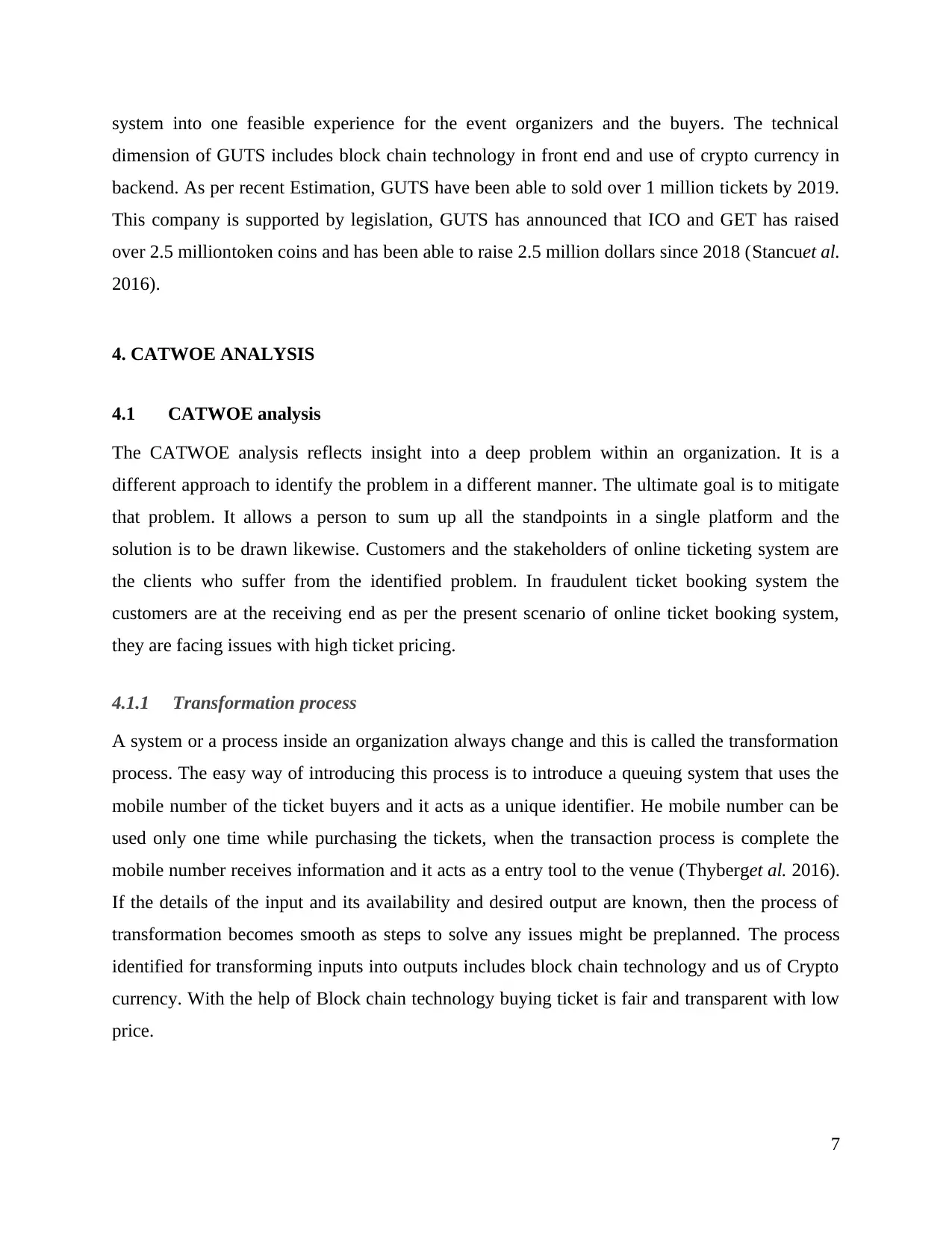
system into one feasible experience for the event organizers and the buyers. The technical
dimension of GUTS includes block chain technology in front end and use of crypto currency in
backend. As per recent Estimation, GUTS have been able to sold over 1 million tickets by 2019.
This company is supported by legislation, GUTS has announced that ICO and GET has raised
over 2.5 milliontoken coins and has been able to raise 2.5 million dollars since 2018 (Stancuet al.
2016).
4. CATWOE ANALYSIS
4.1 CATWOE analysis
The CATWOE analysis reflects insight into a deep problem within an organization. It is a
different approach to identify the problem in a different manner. The ultimate goal is to mitigate
that problem. It allows a person to sum up all the standpoints in a single platform and the
solution is to be drawn likewise. Customers and the stakeholders of online ticketing system are
the clients who suffer from the identified problem. In fraudulent ticket booking system the
customers are at the receiving end as per the present scenario of online ticket booking system,
they are facing issues with high ticket pricing.
4.1.1 Transformation process
A system or a process inside an organization always change and this is called the transformation
process. The easy way of introducing this process is to introduce a queuing system that uses the
mobile number of the ticket buyers and it acts as a unique identifier. He mobile number can be
used only one time while purchasing the tickets, when the transaction process is complete the
mobile number receives information and it acts as a entry tool to the venue (Thyberget al. 2016).
If the details of the input and its availability and desired output are known, then the process of
transformation becomes smooth as steps to solve any issues might be preplanned. The process
identified for transforming inputs into outputs includes block chain technology and us of Crypto
currency. With the help of Block chain technology buying ticket is fair and transparent with low
price.
7
dimension of GUTS includes block chain technology in front end and use of crypto currency in
backend. As per recent Estimation, GUTS have been able to sold over 1 million tickets by 2019.
This company is supported by legislation, GUTS has announced that ICO and GET has raised
over 2.5 milliontoken coins and has been able to raise 2.5 million dollars since 2018 (Stancuet al.
2016).
4. CATWOE ANALYSIS
4.1 CATWOE analysis
The CATWOE analysis reflects insight into a deep problem within an organization. It is a
different approach to identify the problem in a different manner. The ultimate goal is to mitigate
that problem. It allows a person to sum up all the standpoints in a single platform and the
solution is to be drawn likewise. Customers and the stakeholders of online ticketing system are
the clients who suffer from the identified problem. In fraudulent ticket booking system the
customers are at the receiving end as per the present scenario of online ticket booking system,
they are facing issues with high ticket pricing.
4.1.1 Transformation process
A system or a process inside an organization always change and this is called the transformation
process. The easy way of introducing this process is to introduce a queuing system that uses the
mobile number of the ticket buyers and it acts as a unique identifier. He mobile number can be
used only one time while purchasing the tickets, when the transaction process is complete the
mobile number receives information and it acts as a entry tool to the venue (Thyberget al. 2016).
If the details of the input and its availability and desired output are known, then the process of
transformation becomes smooth as steps to solve any issues might be preplanned. The process
identified for transforming inputs into outputs includes block chain technology and us of Crypto
currency. With the help of Block chain technology buying ticket is fair and transparent with low
price.
7
Paraphrase This Document
Need a fresh take? Get an instant paraphrase of this document with our AI Paraphraser
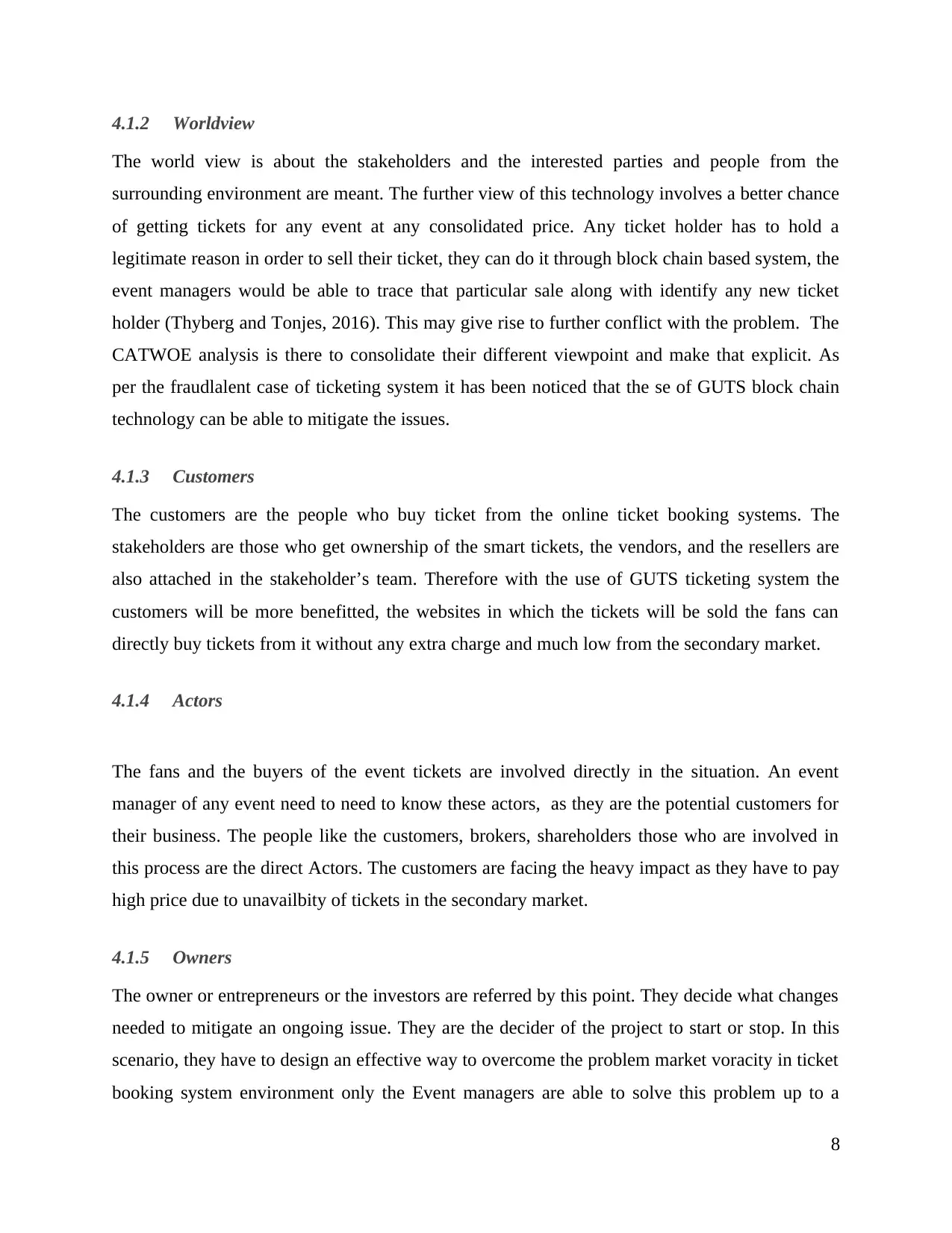
4.1.2 Worldview
The world view is about the stakeholders and the interested parties and people from the
surrounding environment are meant. The further view of this technology involves a better chance
of getting tickets for any event at any consolidated price. Any ticket holder has to hold a
legitimate reason in order to sell their ticket, they can do it through block chain based system, the
event managers would be able to trace that particular sale along with identify any new ticket
holder (Thyberg and Tonjes, 2016). This may give rise to further conflict with the problem. The
CATWOE analysis is there to consolidate their different viewpoint and make that explicit. As
per the fraudlalent case of ticketing system it has been noticed that the se of GUTS block chain
technology can be able to mitigate the issues.
4.1.3 Customers
The customers are the people who buy ticket from the online ticket booking systems. The
stakeholders are those who get ownership of the smart tickets, the vendors, and the resellers are
also attached in the stakeholder’s team. Therefore with the use of GUTS ticketing system the
customers will be more benefitted, the websites in which the tickets will be sold the fans can
directly buy tickets from it without any extra charge and much low from the secondary market.
4.1.4 Actors
The fans and the buyers of the event tickets are involved directly in the situation. An event
manager of any event need to need to know these actors, as they are the potential customers for
their business. The people like the customers, brokers, shareholders those who are involved in
this process are the direct Actors. The customers are facing the heavy impact as they have to pay
high price due to unavailbity of tickets in the secondary market.
4.1.5 Owners
The owner or entrepreneurs or the investors are referred by this point. They decide what changes
needed to mitigate an ongoing issue. They are the decider of the project to start or stop. In this
scenario, they have to design an effective way to overcome the problem market voracity in ticket
booking system environment only the Event managers are able to solve this problem up to a
8
The world view is about the stakeholders and the interested parties and people from the
surrounding environment are meant. The further view of this technology involves a better chance
of getting tickets for any event at any consolidated price. Any ticket holder has to hold a
legitimate reason in order to sell their ticket, they can do it through block chain based system, the
event managers would be able to trace that particular sale along with identify any new ticket
holder (Thyberg and Tonjes, 2016). This may give rise to further conflict with the problem. The
CATWOE analysis is there to consolidate their different viewpoint and make that explicit. As
per the fraudlalent case of ticketing system it has been noticed that the se of GUTS block chain
technology can be able to mitigate the issues.
4.1.3 Customers
The customers are the people who buy ticket from the online ticket booking systems. The
stakeholders are those who get ownership of the smart tickets, the vendors, and the resellers are
also attached in the stakeholder’s team. Therefore with the use of GUTS ticketing system the
customers will be more benefitted, the websites in which the tickets will be sold the fans can
directly buy tickets from it without any extra charge and much low from the secondary market.
4.1.4 Actors
The fans and the buyers of the event tickets are involved directly in the situation. An event
manager of any event need to need to know these actors, as they are the potential customers for
their business. The people like the customers, brokers, shareholders those who are involved in
this process are the direct Actors. The customers are facing the heavy impact as they have to pay
high price due to unavailbity of tickets in the secondary market.
4.1.5 Owners
The owner or entrepreneurs or the investors are referred by this point. They decide what changes
needed to mitigate an ongoing issue. They are the decider of the project to start or stop. In this
scenario, they have to design an effective way to overcome the problem market voracity in ticket
booking system environment only the Event managers are able to solve this problem up to a
8
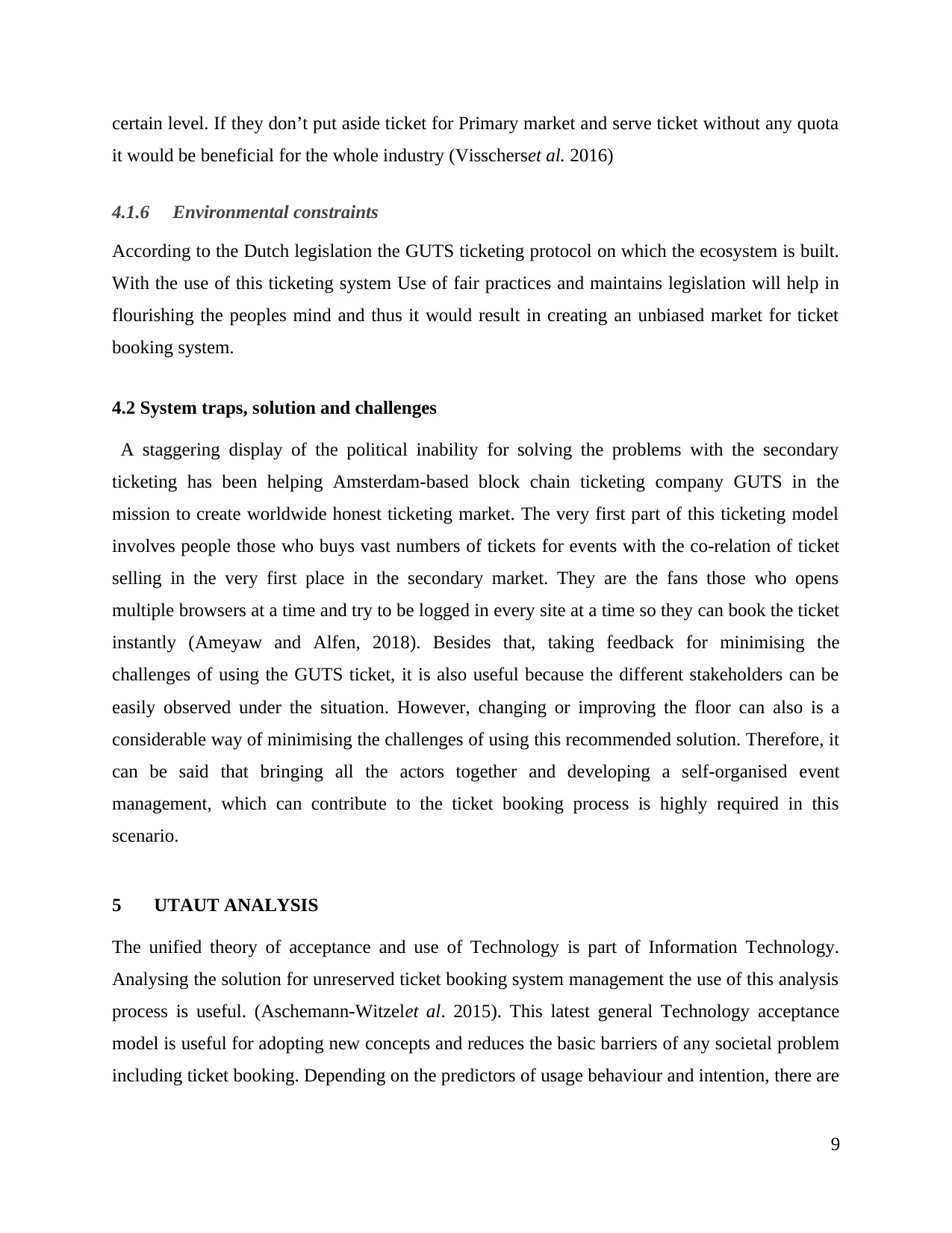
certain level. If they don’t put aside ticket for Primary market and serve ticket without any quota
it would be beneficial for the whole industry (Visscherset al. 2016)
4.1.6 Environmental constraints
According to the Dutch legislation the GUTS ticketing protocol on which the ecosystem is built.
With the use of this ticketing system Use of fair practices and maintains legislation will help in
flourishing the peoples mind and thus it would result in creating an unbiased market for ticket
booking system.
4.2 System traps, solution and challenges
A staggering display of the political inability for solving the problems with the secondary
ticketing has been helping Amsterdam-based block chain ticketing company GUTS in the
mission to create worldwide honest ticketing market. The very first part of this ticketing model
involves people those who buys vast numbers of tickets for events with the co-relation of ticket
selling in the very first place in the secondary market. They are the fans those who opens
multiple browsers at a time and try to be logged in every site at a time so they can book the ticket
instantly (Ameyaw and Alfen, 2018). Besides that, taking feedback for minimising the
challenges of using the GUTS ticket, it is also useful because the different stakeholders can be
easily observed under the situation. However, changing or improving the floor can also is a
considerable way of minimising the challenges of using this recommended solution. Therefore, it
can be said that bringing all the actors together and developing a self-organised event
management, which can contribute to the ticket booking process is highly required in this
scenario.
5 UTAUT ANALYSIS
The unified theory of acceptance and use of Technology is part of Information Technology.
Analysing the solution for unreserved ticket booking system management the use of this analysis
process is useful. (Aschemann-Witzelet al. 2015). This latest general Technology acceptance
model is useful for adopting new concepts and reduces the basic barriers of any societal problem
including ticket booking. Depending on the predictors of usage behaviour and intention, there are
9
it would be beneficial for the whole industry (Visscherset al. 2016)
4.1.6 Environmental constraints
According to the Dutch legislation the GUTS ticketing protocol on which the ecosystem is built.
With the use of this ticketing system Use of fair practices and maintains legislation will help in
flourishing the peoples mind and thus it would result in creating an unbiased market for ticket
booking system.
4.2 System traps, solution and challenges
A staggering display of the political inability for solving the problems with the secondary
ticketing has been helping Amsterdam-based block chain ticketing company GUTS in the
mission to create worldwide honest ticketing market. The very first part of this ticketing model
involves people those who buys vast numbers of tickets for events with the co-relation of ticket
selling in the very first place in the secondary market. They are the fans those who opens
multiple browsers at a time and try to be logged in every site at a time so they can book the ticket
instantly (Ameyaw and Alfen, 2018). Besides that, taking feedback for minimising the
challenges of using the GUTS ticket, it is also useful because the different stakeholders can be
easily observed under the situation. However, changing or improving the floor can also is a
considerable way of minimising the challenges of using this recommended solution. Therefore, it
can be said that bringing all the actors together and developing a self-organised event
management, which can contribute to the ticket booking process is highly required in this
scenario.
5 UTAUT ANALYSIS
The unified theory of acceptance and use of Technology is part of Information Technology.
Analysing the solution for unreserved ticket booking system management the use of this analysis
process is useful. (Aschemann-Witzelet al. 2015). This latest general Technology acceptance
model is useful for adopting new concepts and reduces the basic barriers of any societal problem
including ticket booking. Depending on the predictors of usage behaviour and intention, there are
9
⊘ This is a preview!⊘
Do you want full access?
Subscribe today to unlock all pages.

Trusted by 1+ million students worldwide
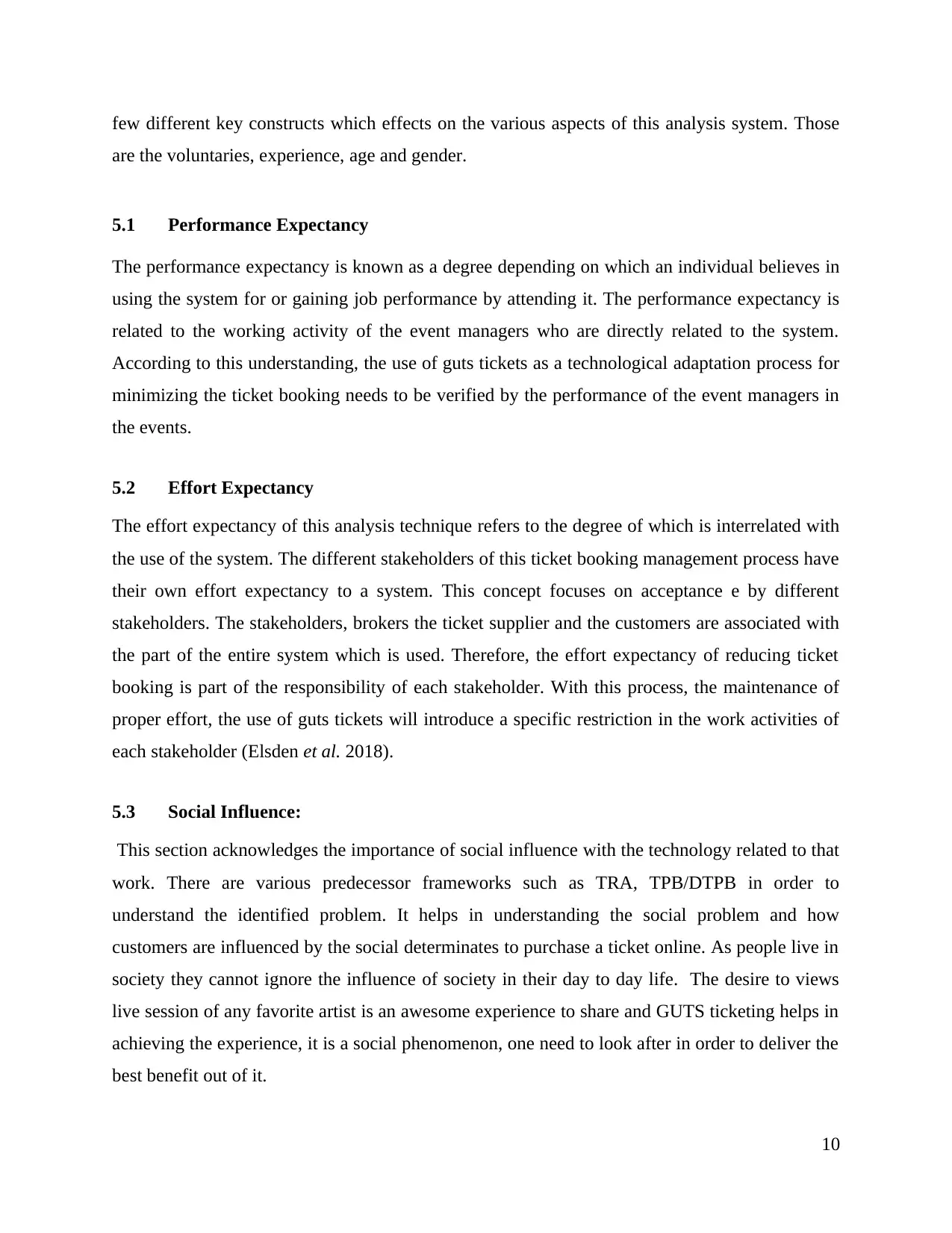
few different key constructs which effects on the various aspects of this analysis system. Those
are the voluntaries, experience, age and gender.
5.1 Performance Expectancy
The performance expectancy is known as a degree depending on which an individual believes in
using the system for or gaining job performance by attending it. The performance expectancy is
related to the working activity of the event managers who are directly related to the system.
According to this understanding, the use of guts tickets as a technological adaptation process for
minimizing the ticket booking needs to be verified by the performance of the event managers in
the events.
5.2 Effort Expectancy
The effort expectancy of this analysis technique refers to the degree of which is interrelated with
the use of the system. The different stakeholders of this ticket booking management process have
their own effort expectancy to a system. This concept focuses on acceptance e by different
stakeholders. The stakeholders, brokers the ticket supplier and the customers are associated with
the part of the entire system which is used. Therefore, the effort expectancy of reducing ticket
booking is part of the responsibility of each stakeholder. With this process, the maintenance of
proper effort, the use of guts tickets will introduce a specific restriction in the work activities of
each stakeholder (Elsden et al. 2018).
5.3 Social Influence:
This section acknowledges the importance of social influence with the technology related to that
work. There are various predecessor frameworks such as TRA, TPB/DTPB in order to
understand the identified problem. It helps in understanding the social problem and how
customers are influenced by the social determinates to purchase a ticket online. As people live in
society they cannot ignore the influence of society in their day to day life. The desire to views
live session of any favorite artist is an awesome experience to share and GUTS ticketing helps in
achieving the experience, it is a social phenomenon, one need to look after in order to deliver the
best benefit out of it.
10
are the voluntaries, experience, age and gender.
5.1 Performance Expectancy
The performance expectancy is known as a degree depending on which an individual believes in
using the system for or gaining job performance by attending it. The performance expectancy is
related to the working activity of the event managers who are directly related to the system.
According to this understanding, the use of guts tickets as a technological adaptation process for
minimizing the ticket booking needs to be verified by the performance of the event managers in
the events.
5.2 Effort Expectancy
The effort expectancy of this analysis technique refers to the degree of which is interrelated with
the use of the system. The different stakeholders of this ticket booking management process have
their own effort expectancy to a system. This concept focuses on acceptance e by different
stakeholders. The stakeholders, brokers the ticket supplier and the customers are associated with
the part of the entire system which is used. Therefore, the effort expectancy of reducing ticket
booking is part of the responsibility of each stakeholder. With this process, the maintenance of
proper effort, the use of guts tickets will introduce a specific restriction in the work activities of
each stakeholder (Elsden et al. 2018).
5.3 Social Influence:
This section acknowledges the importance of social influence with the technology related to that
work. There are various predecessor frameworks such as TRA, TPB/DTPB in order to
understand the identified problem. It helps in understanding the social problem and how
customers are influenced by the social determinates to purchase a ticket online. As people live in
society they cannot ignore the influence of society in their day to day life. The desire to views
live session of any favorite artist is an awesome experience to share and GUTS ticketing helps in
achieving the experience, it is a social phenomenon, one need to look after in order to deliver the
best benefit out of it.
10
Paraphrase This Document
Need a fresh take? Get an instant paraphrase of this document with our AI Paraphraser
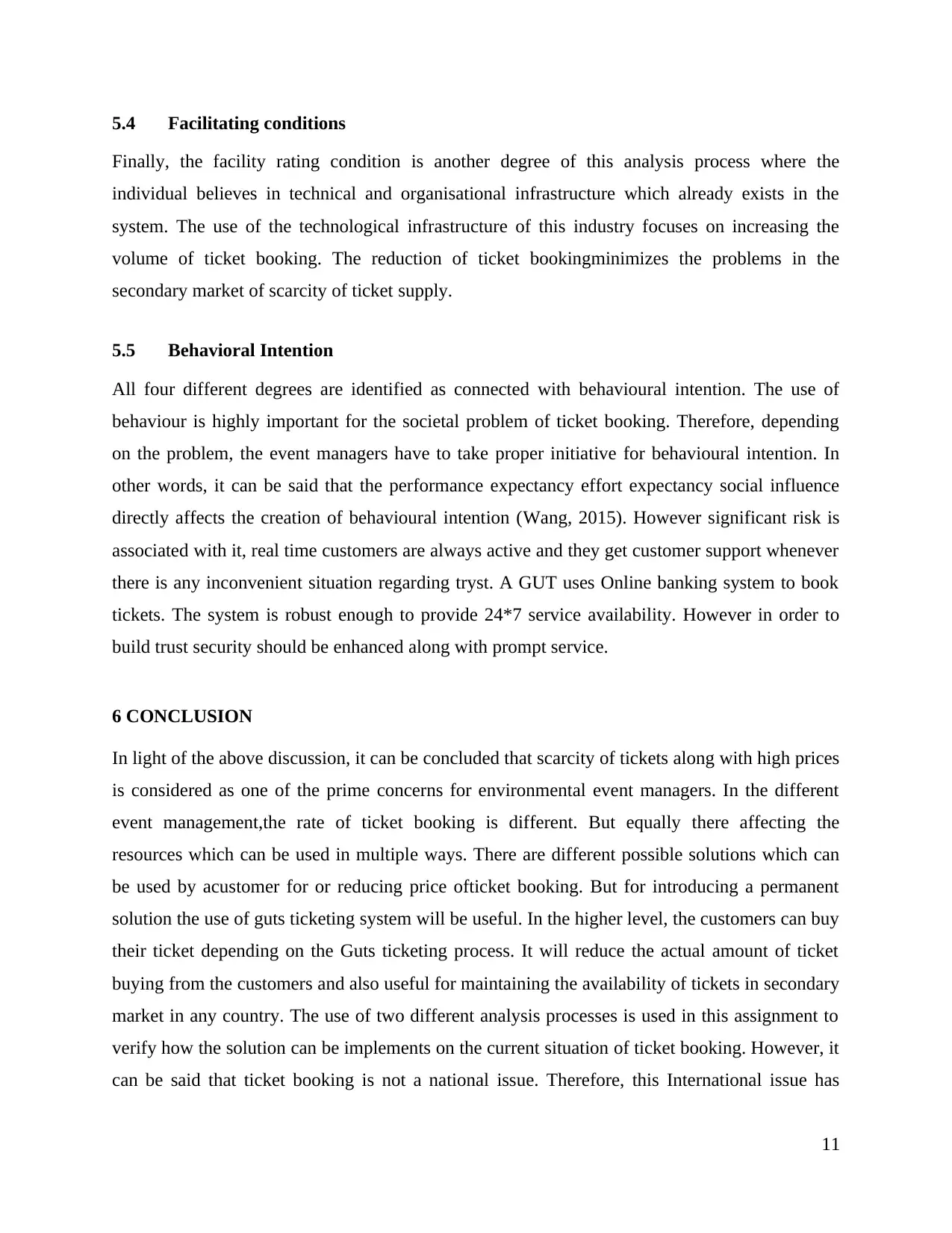
5.4 Facilitating conditions
Finally, the facility rating condition is another degree of this analysis process where the
individual believes in technical and organisational infrastructure which already exists in the
system. The use of the technological infrastructure of this industry focuses on increasing the
volume of ticket booking. The reduction of ticket bookingminimizes the problems in the
secondary market of scarcity of ticket supply.
5.5 Behavioral Intention
All four different degrees are identified as connected with behavioural intention. The use of
behaviour is highly important for the societal problem of ticket booking. Therefore, depending
on the problem, the event managers have to take proper initiative for behavioural intention. In
other words, it can be said that the performance expectancy effort expectancy social influence
directly affects the creation of behavioural intention (Wang, 2015). However significant risk is
associated with it, real time customers are always active and they get customer support whenever
there is any inconvenient situation regarding tryst. A GUT uses Online banking system to book
tickets. The system is robust enough to provide 24*7 service availability. However in order to
build trust security should be enhanced along with prompt service.
6 CONCLUSION
In light of the above discussion, it can be concluded that scarcity of tickets along with high prices
is considered as one of the prime concerns for environmental event managers. In the different
event management,the rate of ticket booking is different. But equally there affecting the
resources which can be used in multiple ways. There are different possible solutions which can
be used by acustomer for or reducing price ofticket booking. But for introducing a permanent
solution the use of guts ticketing system will be useful. In the higher level, the customers can buy
their ticket depending on the Guts ticketing process. It will reduce the actual amount of ticket
buying from the customers and also useful for maintaining the availability of tickets in secondary
market in any country. The use of two different analysis processes is used in this assignment to
verify how the solution can be implements on the current situation of ticket booking. However, it
can be said that ticket booking is not a national issue. Therefore, this International issue has
11
Finally, the facility rating condition is another degree of this analysis process where the
individual believes in technical and organisational infrastructure which already exists in the
system. The use of the technological infrastructure of this industry focuses on increasing the
volume of ticket booking. The reduction of ticket bookingminimizes the problems in the
secondary market of scarcity of ticket supply.
5.5 Behavioral Intention
All four different degrees are identified as connected with behavioural intention. The use of
behaviour is highly important for the societal problem of ticket booking. Therefore, depending
on the problem, the event managers have to take proper initiative for behavioural intention. In
other words, it can be said that the performance expectancy effort expectancy social influence
directly affects the creation of behavioural intention (Wang, 2015). However significant risk is
associated with it, real time customers are always active and they get customer support whenever
there is any inconvenient situation regarding tryst. A GUT uses Online banking system to book
tickets. The system is robust enough to provide 24*7 service availability. However in order to
build trust security should be enhanced along with prompt service.
6 CONCLUSION
In light of the above discussion, it can be concluded that scarcity of tickets along with high prices
is considered as one of the prime concerns for environmental event managers. In the different
event management,the rate of ticket booking is different. But equally there affecting the
resources which can be used in multiple ways. There are different possible solutions which can
be used by acustomer for or reducing price ofticket booking. But for introducing a permanent
solution the use of guts ticketing system will be useful. In the higher level, the customers can buy
their ticket depending on the Guts ticketing process. It will reduce the actual amount of ticket
buying from the customers and also useful for maintaining the availability of tickets in secondary
market in any country. The use of two different analysis processes is used in this assignment to
verify how the solution can be implements on the current situation of ticket booking. However, it
can be said that ticket booking is not a national issue. Therefore, this International issue has
11
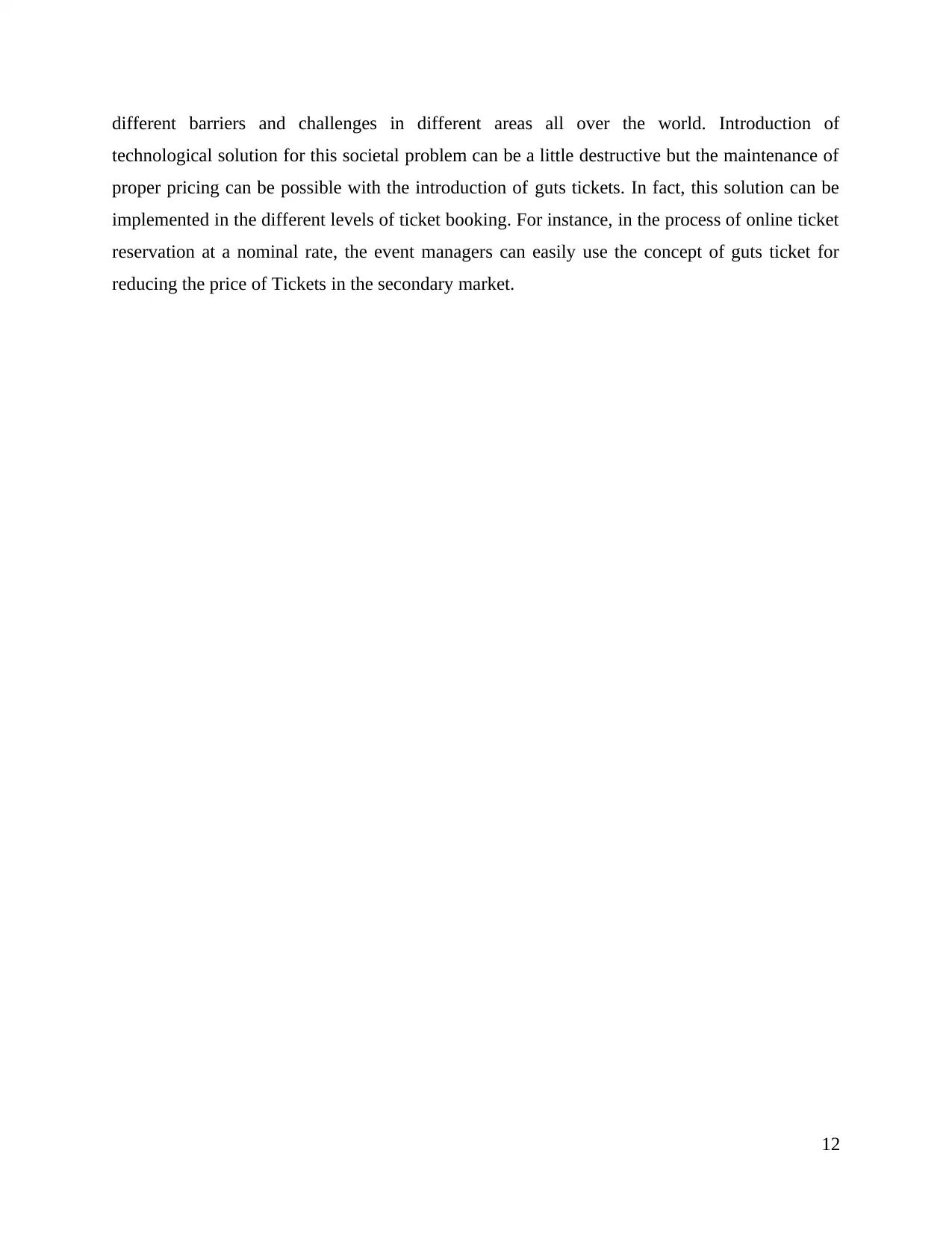
different barriers and challenges in different areas all over the world. Introduction of
technological solution for this societal problem can be a little destructive but the maintenance of
proper pricing can be possible with the introduction of guts tickets. In fact, this solution can be
implemented in the different levels of ticket booking. For instance, in the process of online ticket
reservation at a nominal rate, the event managers can easily use the concept of guts ticket for
reducing the price of Tickets in the secondary market.
12
technological solution for this societal problem can be a little destructive but the maintenance of
proper pricing can be possible with the introduction of guts tickets. In fact, this solution can be
implemented in the different levels of ticket booking. For instance, in the process of online ticket
reservation at a nominal rate, the event managers can easily use the concept of guts ticket for
reducing the price of Tickets in the secondary market.
12
⊘ This is a preview!⊘
Do you want full access?
Subscribe today to unlock all pages.

Trusted by 1+ million students worldwide
1 out of 13
Related Documents
Your All-in-One AI-Powered Toolkit for Academic Success.
+13062052269
info@desklib.com
Available 24*7 on WhatsApp / Email
![[object Object]](/_next/static/media/star-bottom.7253800d.svg)
Unlock your academic potential
Copyright © 2020–2025 A2Z Services. All Rights Reserved. Developed and managed by ZUCOL.





